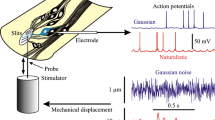Summary
The linearity of the retinal action potentials from light adapted eyes of intact wolf spiders has been tested using incremental rectangular shaped stimuli and sine wave stimuli. It has been shown that the flicker responses elicited by 8 % incremental flash trains may be predicted by linear superposition of the responses to the component 8 % incremental flashes. In turn, these flash responses can be predicted from linear superposition of the response to an 8 % incremental step by inverting this step response and adding it to itself at the duration of the flash. By tuned amplification, responses at the frequencies of the first two Fourier components of incremental rectangular wave stimuli have been shown to vary directly in amplitude with the amplitudes of these components as functions of duty cycle. Likewise, responses elicited by sine wave incremental stimuli have amplitudes which vary linearly with stimulus amplitudes and which contain inappreciable harmonics of the stimulus frequencies. Linear transfer functions have been fitted to the amplitudes and phases of sine wave responses as functions of frequency, and the responses to 8 % incremental steps have been satisfactorily predicted therefrom. Finally, from high frequency sine wave responses it is proposed to account for the latent period of the retinal action potential by a large number of exponential delay elements (poles), in the example given on the order of 10 to 12.
Résumé
La linéarité des potentiels rétiniens pris de l'oeil adapté à la lumière de la tarantule a été étudiée avec des incréments rectangulaires et des variations sinusoidales d'une intensité constante. On a démontré que les réponses évoquées par des increments de 8 % présentés rhythmiquement peuvent être obtenues par superposition des réactions aux éclairs isolés aussi de 8 %. Ces dernières-ci peuvent être calculées par l'addition d'une réaction à une fonction d'étage de 8 % et la même avec la polarité opposée et séparée pour la durée de l'éclair.
Avec de l'amplification sélective la réponse dans les premiers components Fourier d'un stimulus rectangulaire incrémental est dans un rapport direct avec l'amplitude des mêmes components du stimulus, quand la durée lumineuse se change.
Aussi les réponses aux stimulus sinusoidales varient linéairement avec les amplitudes du stimulus et ne contiennent pas des harmoniques appréciables.
Des fonctions de transfer linéaires ont été adaptées aux courbes d'amplitude et de phase et les réponses aux étages de 8 % pouvaient être calculées assez bien de cela. Quant aux réponses haut-fréquentes on propose de décrire le période latent de l'ERG par un grand nombre d'éléments de délai (des poles), par exemple 10 à 12.
Zusammenfassung
Die Linearität von Potentialen der Retina des an Licht adaptierten Auges der Tarantella ist untersucht worden mit plötzlichen Änderungen der Lichtintensität und Änderungen mit einem Sinuscharakter. Es wird gezeigt, dass Flimmerreaktionen auf 8 % zusätzliche repetierende Blitze vorausgesagt werden können durch lineäre Aufzählung der Reaktionen auf 8 % Einzelblitze.
Diese letzten können wieder zusammengesetzt werden, wenn man die Reaktion auf 8 % Erhöhung der Intensität umkehrt und nach Ablauf des Blitzes aufzählt.
Durch selektive Verstärkung ist gezeigt worden, dass die ersten zwei Fourier Komponenten von Reaktionen auf rechteckige zusätzliche Reizung eindeutig mit den Amplituden der Fourier Komponenten vom Reiz zusammenhängen, wenn sich das Licht-Dunkel Verhältnis ändert. Uebereinstimmend zeigen Reaktionen auf Sinus Reizung eine Amplitude, die in einer linearen Beziehung zu der Original-Amplitude steht und auch sehr wenig Verzerrung zeigt.
Lineare Uebertragsfunktionen sind an die Amplituden und Phasen Verhältnisse angepasst worden und die Antworten auf 8 % Änderungen konnten mit gutem Erfolg vorausgesagt werden.
Am Ende wird gestellt, dass die Latenzzeit von retinalen Potentialen beschrieben werden kann mit einer grossen Anzahl von exponentiellen Verzögerungselementen (Pohlen), zum Beispiel 10 bis 12.
Similar content being viewed by others
References
DeVoe, R. D. (1962) Linear Superposition of Retinal Action Potentials to Predict Electrical Flicker Responses from the Eye of the Wolf Spider, Lycosa baltimoriana (Keyserling), J. gen. Physiol., 46, 75–96.
—, (1963) Linear Relations Between Stimulus Amplitudes and Amplitudes of Retinal Action Potentials from the Eye of the Wolf Spider, J. gen. Physiol., 47, 13–32.
Fuortes, M. G. H. & Hodgkin, A. (1964) Changes in Time Scale and Sensitivity in Limulus ommatidia. Docum. Ophthal., 18, 284–286.
Hermann, H. T. & Stark, L. (1963) Single Unit Responses in a Primitive Photoreceptor Organ, J. Neurophysiol., 26, 215–228.
Kelly, D. H. (1964) Sine Waves and Flicker Fusion. Docum. Ophthal., 18, 16–35.
Kirschfeld, K. (1961) Quantitative Beziehungen zwischen Lichtreiz und monophasischem Elektroretinogramm bei Rüsselkäfern, Z. vergl. Physiol. 44, 371–413.
deLange, H., Dzn (1954) Relationship Between Critical Flicker Frequency and a Set of Low Frequency Characteristics of the Eye, J. opt. Soc. Amer., 44, 380–389.
—, (1961) Eye's Response at Flicker Fusion to Square-wave Modulation of a Test Field Surrounded by a Large Steady Field of Equal Mean Luminance, J. opt. Soc. Amer., 51, 415–421.
Widmann, E. (1908) Über den feineren Bau der Augen einiger Spinnen, Z. wiss. Zool. 90, 258–312.
Author information
Authors and Affiliations
Additional information
This investigation was supported in part by U.S. Public Health Service Research Grant NB-03750 from the National Institute of Neurological Diseases and Blindness.
From the Rockefeller Institute and The Department of Physiology, The Johns Hopkins University School of Medicine.
Rights and permissions
About this article
Cite this article
DeVoe, R.D. Linear electrical flicker responses from the eye of the wolf spider. Doc Ophthalmol 18, 128–136 (1964). https://doi.org/10.1007/BF00160569
Issue Date:
DOI: https://doi.org/10.1007/BF00160569




